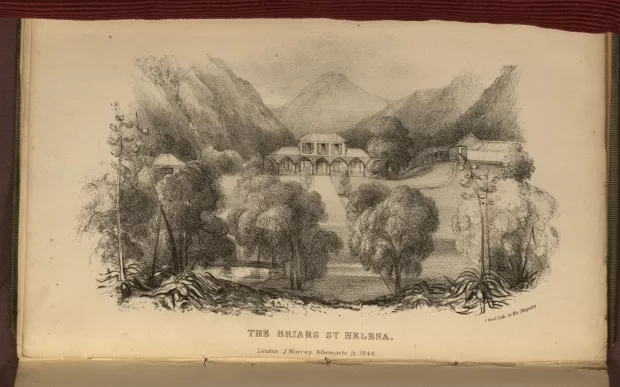Creation Date
1845
Height
13 cm
Width
22 cm
Description
This image of Mount Helena marks a turning point for volcanic depictions in Romantic culture. The fear and awe once evoked by images of rampant volcanoes is little more; instead, Mount Helena is seen as powerless and at rest. One could draw a political parallel to Napoleon as he is also “at rest,” lacking the power he once possessed. The volcano is distant and appears as an afterthought in the image. Because scientists knew that the volcano had become extinct, the image does not give any sense of anxiety that it will erupt. Instead, the knowledge gained by volcanologists of the time has contributed to a scenic—not fear-inducing—view of Mount Helena.
Trees line the foreground of this image and follow a pavement to a house, The Briars, in the distance. The Briars sits at the middle of the image: it is a fair-sized house with two floors. In the background, a calm Mount Helena looms over the house and is surrounded by more mountains.
The Briars St. Helena" was engraved by Charles Graf for “her majesty,” though it is never clear to whom Graf is referring. According to Elizabeth Abell, this image was drawn the day Napoleon reached St. Helena; however, the artist’s name is not given. Copies of this drawing were then published in Abell’s Recollections of the Emperor Napoleon decades later. The delay in publication was to protect Abell’s reputation, as she would have been shunned by the British public for befriending Napoleon. A copy of this book entered the private collection of Chester H. Thordarson before arriving in Special Collections at the University of Wisconsin—Madison.
This image of Mount Helena marks a turning point for volcanic depictions in Romantic culture. The fear and awe once evoked by images of rampant volcanoes is little more; instead, Mt. Helena is seen as powerless and at rest. One could draw a political parallel to Napoleon as he is also “at rest,” lacking the power he once possessed. The volcano is distant and appears as an afterthought in the image. Because scientists knew that the volcano had become extinct, the image does not give any sense of anxiety that it will erupt. Instead, the knowledge gained by volcanologists of the time has contributed to a scenic—not fear-inducing—view of Mt. Helena.
Charles Graf signed his drawing “to her majesty.” It can therefore be concluded that the image was intended to be viewed by royalty—though to which royalty Graf was referring is still unknown. Whether or not the drawing was ever viewed by “her majesty” is also unknown. However, the drawing was transformed into an aquatint and published in Elizabeth Abell's Recollections of the Emperor Napoleon in order to show the reading audience what The Briars looked like upon Napoleon’s arrival. The image’s powerless volcano functions as a reflection of Napoleon’s own powerlessness on the volcanic island.
Associated Works
Locations Description
Longwood House
Napoleon Bonaparte and his entourage—composed of persons hailing from multiple countries, including the artist C. Graf Lith—resided at Longwood House from 1815 until Napoleon’s death in 1821. The house had formally been the residence of the Lieutenant Governor, but was renovated by the British to house Napoleon during his exile. Napoleon resided at The Briars during the two-month renovation (B. Weider, Murder of Napoleon 91-95).
Saint Helena
Named after Saint Helen of Constantinople, Saint Helena is Britain’s second oldest colony, colonized in 1502. The British used this island as a place of exile for thousands of prisoners, its most notable inhabitant being Napoleon Bonaparte. The island consists of two major volcanoes and several smaller ones. All volcanoes on the island, however, have been extinct for over a thousand years (G. Martineau Napoleon’s St. Helena 66-77).
The Briars
This estate housed Napoleon Bonaparte and his entourage, including C. Graf Lith, during his first two months of exile at St. Helena. The house was owned by the Balcombe family. During his time at this estate, Napoleon formed a friendship with Elizabeth Abell (at the time a young girl). Napoleon would later move out of The Briars and into the newly renovated Longwood House (B. Weider, Murder of Napoleon 83-90).
Publisher
John Murray
Collection
Accession Number
F3944 A14

